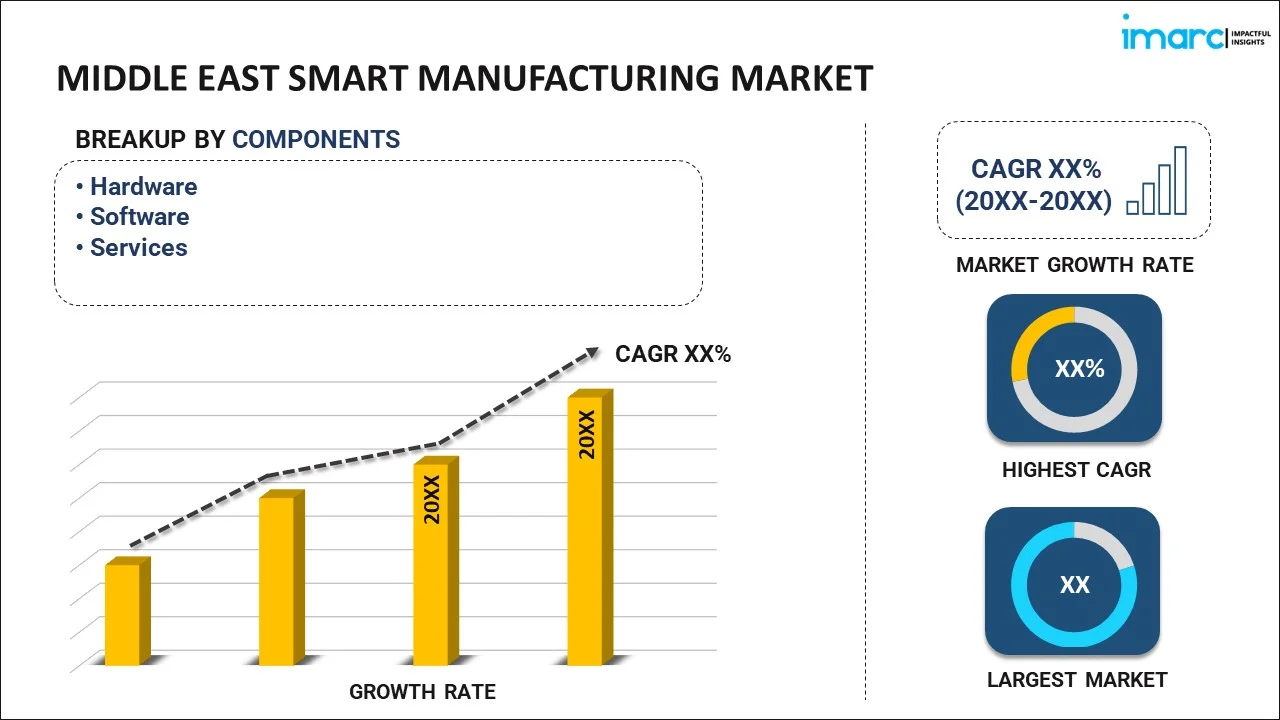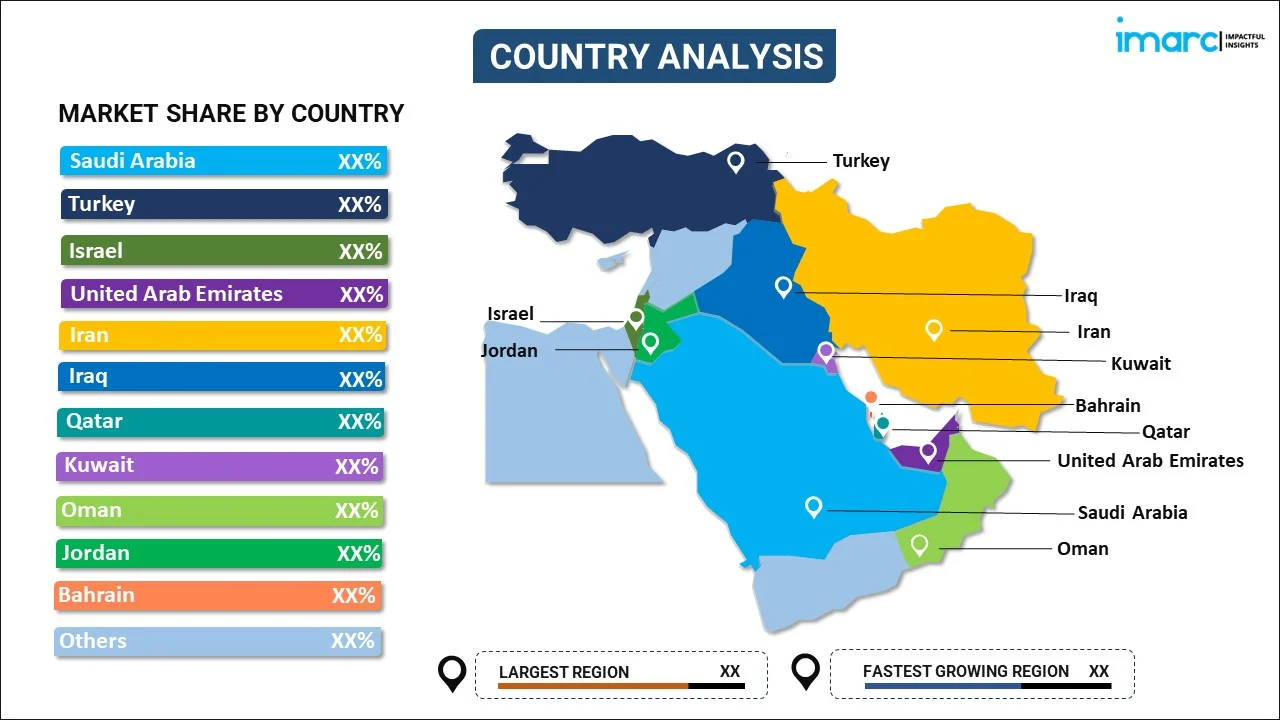
Middle East Smart Manufacturing Market Report by Component (Hardware, Software, Services), Technology (Machine Execution Systems, Programmable Logic Controller, Enterprise Resource Planning, SCADA, Discrete Control Systems, Human Machine Interface, Machine Vision, 3D Printing, Product Lifecycle Management, and Plant Asset Management), End Use (Automotive, Aerospace and Defense, Chemicals and Materials, Healthcare, Industrial Equipment, Electronics, Food and Agriculture, Oil and Gas, and Others), and Country 2024-2032
Market Overview:
Middle East smart manufacturing market size is projected to exhibit a growth rate (CAGR) of 14.88% during 2024-2032. The increasing demand for smart manufacturing technologies, which aim to improve overall efficiency by optimizing processes, reducing waste, and minimizing downtime, is driving the market.
|
Report Attribute
|
Key Statistics
|
|---|---|
|
Base Year
|
2023 |
|
Forecast Years
|
2024-2032 |
|
Historical Years
|
2018-2023
|
| Market Growth Rate (2024-2032) | 14.88% |
Smart manufacturing is a modern approach to industrial production that leverages advanced technologies such as the Internet of Things (IoT), artificial intelligence (AI), and data analytics to optimize and automate the manufacturing process. It integrates physical machinery with digital technology to create intelligent, interconnected systems that can monitor, analyze, and improve efficiency in real time. Smart manufacturing enables the collection of vast amounts of data from various sources within a production environment, allowing for predictive maintenance, resource optimization, and enhanced decision-making. This approach fosters flexibility, agility, and adaptability in responding to dynamic market demands. By connecting machines and processes, smart manufacturing facilitates the creation of a more responsive, interconnected, and efficient manufacturing ecosystem, ultimately leading to improved productivity, reduced costs, and enhanced overall competitiveness for businesses in the manufacturing sector.
Middle East Smart Manufacturing Market Trends:
The smart manufacturing market in the Middle East is experiencing unprecedented growth, driven by a confluence of factors that underscore the industry's evolution. Firstly, the rising demand for increased efficiency and productivity has propelled the adoption of smart manufacturing technologies. Moreover, the integration of IoT devices has revolutionized production processes, creating a seamless network of interconnected devices that can communicate and optimize operations in real time. Additionally, the push towards sustainability and environmental consciousness has spurred the development of smart manufacturing solutions that minimize waste and energy consumption. Furthermore, the advent of AI and machine learning has empowered manufacturers with predictive analytics, enabling them to anticipate maintenance needs and optimize production schedules. Apart from this, the growing emphasis on data-driven decision-making, as manufacturers recognize the value of actionable insights derived from the vast amounts of data generated throughout the production cycle, is expected to drive the smart manufacturing market in the Middle East during the forecast period
Middle East Smart Manufacturing Market Segmentation:
IMARC Group provides an analysis of the key trends in each segment of the market, along with forecasts at the regional and country levels for 2024-2032. Our report has categorized the market based on component, technology, and end use.
Component Insights:

- Hardware
- Software
- Services
The report has provided a detailed breakup and analysis of the market based on the component. This includes hardware, software, and services.
Technology Insights:
- Machine Execution Systems
- Programmable Logic Controller
- Enterprise Resource Planning
- SCADA
- Discrete Control Systems
- Human Machine Interface
- Machine Vision
- 3D Printing
- Product Lifecycle Management
- Plant Asset Management
A detailed breakup and analysis of the market based on the technology have also been provided in the report. This includes machine execution systems, programmable logic controller, enterprise resource planning, SCADA, discrete control systems, human machine interface, machine vision, 3D printing, product lifecycle management, and plant asset management.
End Use Insights:
- Automotive
- Aerospace and Defense
- Chemicals and Materials
- Healthcare
- Industrial Equipment
- Electronics
- Food and Agriculture
- Oil and Gas
- Others
The report has provided a detailed breakup and analysis of the market based on the end use. This includes automotive, aerospace and defense, chemicals and materials, healthcare, industrial equipment, electronics, food and agriculture, oil and gas, and others.
Country Insights:

- Saudi Arabia
- Turkey
- Israel
- United Arab Emirates
- Iran
- Iraq
- Qatar
- Kuwait
- Oman
- Jordan
- Bahrain
- Others
The report has also provided a comprehensive analysis of all the major regional markets, which include Saudi Arabia, Turkey, Israel, United Arab Emirates, Iran, Iraq, Qatar, Kuwait, Oman, Jordan, Bahrain, and Others.
Competitive Landscape:
The market research report has also provided a comprehensive analysis of the competitive landscape in the market. Competitive analysis such as market structure, key player positioning, top winning strategies, competitive dashboard, and company evaluation quadrant has been covered in the report. Also, detailed profiles of all major companies have been provided.
Middle East Smart Manufacturing Market Report Coverage:
| Report Features | Details |
|---|---|
| Base Year of the Analysis | 2023 |
| Historical Period | 2018-2023 |
| Forecast Period | 2024-2032 |
| Units | US$ Million |
| Scope of the Report | Exploration of Historical Trends and Market Outlook, Industry Catalysts and Challenges, Segment-Wise Historical and Future Market Assessment:
|
| Components Covered | Hardware, Software, Services |
| Technologies Covered | Machine Execution Systems, Programmable Logic Controller, Enterprise Resource Planning, SCADA, Discrete Control Systems, Human Machine Interface, Machine Vision, 3D Printing, Product Lifecycle Management, Plant Asset Management |
| End Uses Covered | Automotive, Aerospace and Defense, Chemicals and Materials, Healthcare, Industrial Equipment, Electronics, Food and Agriculture, Oil and Gas, Others |
| Countries Covered | Saudi Arabia, Turkey, Israel, United Arab Emirates, Iran, Iraq, Qatar, Kuwait, Oman, Jordan, Bahrain, Others |
| Customization Scope | 10% Free Customization |
| Report Price and Purchase Option | Single User License: US$ 3699 Five User License: US$ 4699 Corporate License: US$ 5699 |
| Post-Sale Analyst Support | 10-12 Weeks |
| Delivery Format | PDF and Excel through Email (We can also provide the editable version of the report in PPT/Word format on special request) |
Key Questions Answered in This Report:
- How has the Middle East smart manufacturing market performed so far and how will it perform in the coming years?
- What has been the impact of COVID-19 on the Middle East smart manufacturing market?
- What is the breakup of the Middle East smart manufacturing market on the basis of component?
- What is the breakup of the Middle East smart manufacturing market on the basis of technology?
- What is the breakup of the Middle East smart manufacturing market on the basis of end use?
- What are the various stages in the value chain of the Middle East smart manufacturing market?
- What are the key driving factors and challenges in the Middle East smart manufacturing?
- What is the structure of the Middle East smart manufacturing market and who are the key players?
- What is the degree of competition in the Middle East smart manufacturing market?
Key Benefits for Stakeholders:
- IMARC’s industry report offers a comprehensive quantitative analysis of various market segments, historical and current market trends, market forecasts, and dynamics of the Middle East smart manufacturing market from 2018-2032.
- The research report provides the latest information on the market drivers, challenges, and opportunities in the Middle East smart manufacturing market.
- Porter's five forces analysis assist stakeholders in assessing the impact of new entrants, competitive rivalry, supplier power, buyer power, and the threat of substitution. It helps stakeholders to analyze the level of competition within the Middle East smart manufacturing industry and its attractiveness.
- Competitive landscape allows stakeholders to understand their competitive environment and provides an insight into the current positions of key players in the market.
Need more help?
- Speak to our experienced analysts for insights on the current market scenarios.
- Include additional segments and countries to customize the report as per your requirement.
- Gain an unparalleled competitive advantage in your domain by understanding how to utilize the report and positively impacting your operations and revenue.
- For further assistance, please connect with our analysts.
 Inquire Before Buying
Inquire Before Buying
 Speak to an Analyst
Speak to an Analyst
 Request Brochure
Request Brochure
 Request Customization
Request Customization




.webp)




.webp)












